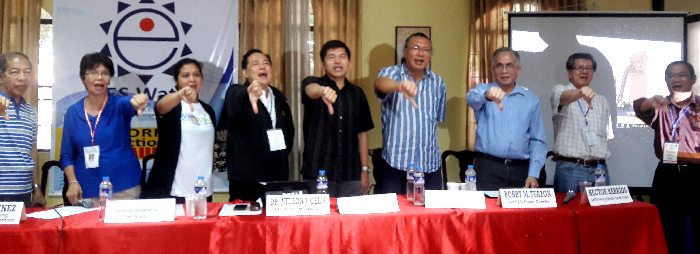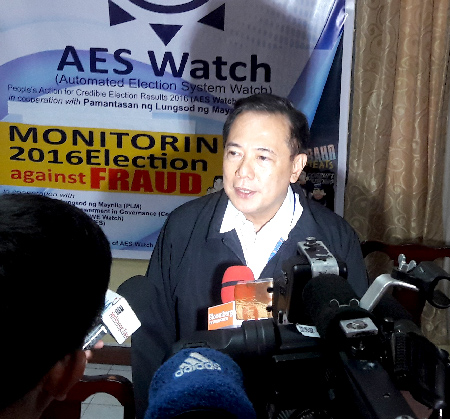On May 11, 2016 – two days after the third automated elections, the multi-sectoral poll watch group, Automated Election System Watch (AES Watch) called for junking the foreign technology supplier, Smartmatic, and for the Commission on Elections (Comelec) to be made to account.
Founded in January 2010 with a membership of more than 40 organizations, institutions, academic institutions, and poll watchdogs, the AES Watch issued the call in the wake of several incidents of voting machine malfunctions, transmission glitches, and repeated non-compliance by Comelec of the minimum system requirements in poll automated as mandated by law. (A few days later, a Smartmatic executive accessed the off-limits transparency server to alter the hash code for reason of “cosmetic changes.” The incident sparked strong protests from election watch groups, national candidates, and even some Comelec commissioners who questioned the Smartmatic entry without Comelec permission.)
AES Watch monitored the May 9 elections at its poll monitoring center, “People’s Action for Credible Elections 2016” (PACER), President Ramon Magsaysay Entrepreneurial Center (PRMEC), Pamantasan ng Lungsod ng Maynila (PLM), Intrumuros, Manila. The monitoring center was through the courtesy of PLM President Lenny de Jesus. Aside from AES Watch, the May 8-12 election monitor was conducted in partnership with the labor watch group WE Watch, United Filipino Seafarers (UFS), student volunteers from the University of the Philippines in Manila (UP-Manila) and PLM, and the Volunteers Against Crime and Corruption (VACC).
A poll of analysts from the Center for People Empowerment in Governance (CenPEG), one of the lead conveners of AES Watch, and members of the multi-sectoral watch group lent their expertise in evaluating the monitoring data and analysis of the overall conduct of the elections.
A final monitoring report will be released by AES Watch soon.
Following is the May 11 press statement of AES Watch:
GAME OVER FOR SMARTMATIC; COMELEC SHOULD BE MADE TO ACCOUNT
Amidst the ecstatic jubilation of winners and their followers and the usual congratulations from PPCRV and some foreign observers, all is not well with the re-designed and uncertified poll automation system for 2016.
The pressures and noise put up by the vigilance of watchdogs, expert observers and the critical public over pre-election and election day system non-compliances or violations of law by Comelec and Smartmatic that exposed the vulnerabilities for cheating of the re-designed and uncertified poll automation system for 2016 – actual hacking, mismatched results, candidates’ names missing, VCMs in undisclosed areas, un-expurgated voters’ list and the No Biometrics, No Vote rule; discrepancies between voter intent and VVPAT/voter receipt; questionable transmission rule on physical importation of all SD cards from the VCMs to the canvassing centers to qualify for electronic transmission, no replacement ballots and VCMs, among others, repeated and in a more widespread scale, the glitches and uncertainties of the old PCOS in 2010 and 2013.
Moreover, the Comelec and its foreign provider now found convenient excuses – through new rules and resolutions- to cover up deceptive outcomes and ill-preparedness of the Comelec in the 2016 automated polls.
We owe it to voters’ and poll watch groups’ vigilance that what could have been a major election disaster characterized by fraud at the national level was mitigated. Contrary to claims of the PPCRV and some foreign observers, however, the elections was far from being a “success” as far as the automation system is concerned – it was even worst compared to the 2010 and 2013 automated elections.
After two automated elections, the third was like on a test run mode again with the passengers (voters) subjected to stress, uncertainties, harassment, long queues and fatigue, and even heat strokes. If automation was supposed to make voting friendly, fast, and convenient, why was voting in thousands of precincts delayed, thousands of vote counting machines (VCMs) broke down leading to voter disenfranchisement, and transmission of ERs foiled by glitches with many BEIs ill-equipped in troubleshooting due to lack of Comelec contingency measures?
In 2010, 9% of PCOS machines failed to transmit ERs; in 2013, transmission failures hit 23% of PCOS machines thus technically disenfranchising 8.6M voters. Last May 9, 2,500 VCMs (with 184 alone in Caraga, La Union, and in the OAV centers) malfunctioned affecting 1.5M voters with manual voting resorted to in many voting areas all over the country. All SD cards from 92,509 clustered precincts whether transmitted or not were “imported” to the C/MBOCs thus opening the system to data manipulation and election rigging. How many ERs were transmitted to be used as a basis for proclaiming election winners is the big question.
The Comelec had all three years to prepare for the last election so that to reason that it had limited time to conduct the exercise is unacceptable. The poll body’s announcement weeks before the election that it was 100% ready was deceptive. In truth, it was ill-prepared and wasted valuable time for the following reasons:
- TEC certification (which includes completion of source code reviews, successful field tests and mock elections) was delayed for 3 months and was issued only a few days before election;
- Voter registration remained fraught with missing names of active voters while those already deceased were still in the list;
- Comelec was non-transparent (no reports were actually released) on whether the May 2-6 FTS which was marred by discrepancies and machine failures was ever completed; likewise, with regard the field tests and mock elections;
- Unresolved poor telecommunications infrastructures which compelled the Comelec to issue Resolution 10083 mandating the manual delivery of all 92,509 SD cards;
- Repeated non-compliance with the minimum system requirements such as digital signatures by the BEIs and BOCs, and the absence of an IRR for RA 8436 or RA 9369 (i.e., amended RA 8436) after 19 years or 9 years of the election modernization law.
With billions of taxpayers’ money spent after 3 automated elections – much of it going to Smartmatic; 80,000 PCOS machines in a garbage dump otherwise called “warehouse” in Laguna, brazen non- or token compliance with the election law, and unaudited expenditures it’s about time for Smartmatic to call it quits and for Comelec to made into account. It’s about time to review the election modernization law.
We call on independent poll watch groups as well as Congress particularly the JCOC on AES to investigate and call for full disclosure on the ill preparedness of the Comelec on complying with the minimum system requirements of the Automation law which caused high-wired tensions, confusion and irregularities, uncertain election numbers and, more importantly, widespread disenfranchisement of voters around the country. Not to forget the Novotel expose of VCMs allegedly stored mysteriously inside rooms reminiscent of the 2010 Antipolo incident where the discovery of 60 PCOS machines inside a house caused uproar on possible fraud.
While we continue to cheer over the fast results, who would ever know if the votes were actually counted right with the complexities of the election system that before election days was never certified, fully tested and continue to conk out even after the seal of the machines had been open for election day? To this day, the issues of pre-programming, 60-30-10 vote pattern, and other irregularities in previous elections have not been fully resolved and will never will be.
As we go the national canvassing, we ask the full disclosure of the transmission results and the physical transportation of the SD cards to the canvassing which would work magic to the numbers of the results.
As euphoria over the fast results dies down, we ask for the investigation of the continued non-compliances of the poll automation law and ask for its amendments, even its repeal for the continued intransigence of the election manager to comply.
We challenge the incoming administration to BEGIN the reform of the election system to make it transparent, accountable, secured, and accurate.
Posted by CenPEG.org, May 19, 2016

GAME OVER: AES Watch conveners and poll volunteers call for the junking of Smartmatic, foreign marketing company which has monopolized the election technology system in 2010, 2013, and 2016. (L-R) Temy Rivera, CenPEG chair; Evi Jimenez, AES Watch coordinator and CenPEG executive director; Anna Leah Escresa, WE Watch; Nelson Celis, AES Watch spokesperson; clean election advocate Atty. Glenn Chong; Toti Casiño, former PCS president; Bobby Tuazon, CenPEG policy studies director; Hector Barrios, AES Watch; and UFS volunteer Engr. Bienvenido Lorque. CenPEG photo

AES Watch spokesperson Nelson Celis being interviewed by media. CenPEG photo
- Probing presidential platforms
- Conference calls for people-centered policy actions for Asian development and peace
- WWII 'comfort women' urge visiting Japanese emperor: OFFICIAL GOV’T APOLOGY, UPHOLD TRUTH, and JUST COMPENSATION
- FEARLESS FORECAST (EPISODE II): Comelec will not comply with e-Commerce Law in 2016 elections
- Fearless forecast: Comelec’s non-compliance with the AES law in 2016 (last of 2 parts)
- Fearless forecast: Comelec will not comply with the AES law in 2016
- CenPEG releases travelogue
- Experts: Nuisance bets reflect disillusionment, uneven playing field
- Partylist solon presses for tax cuts
- The True Cost of a Political Campaign
- Management decisions: Based on RA 9369 or purely Comelec’s?
- CenPEG holds 1st roundtable with media on presidential poll results
- Filipino IT can do it!
- FIT4E: The only transparent solution
- Realpolitik in the maritime tiff
- China’s challenge to PH sovereignty
- Choosing the next president
- Fixing the presidency, reforming the state
- New Comelec chair says he’s open to other election technologies
- SC ruling on AES Watch Pabillo and IBP vs Comelec, Smartmatic-TIM
- Comelec must explain P3.2B unliquidated cash advances
- CONGRESS ASKED TO HOLD DEMO ON PCOS HACKING
- 25 Bishops ask poll body to stop midnight deal with Smartmatic
- Pope Francis: reform and conversion
- 2 poll watch coalitions stage rally vs Comelec-Smartmatic midnight deal
- AES Watch questions Comelec-Smartmatic midnight deal
- ASEAN-India: Building Youth Partnerships through Culture and Entrepreneurship
- CenPEG forges research exchange and partnership with Jinan University
- FOI: Bearing fruit or foiled again?
- Remittance with Representation: The right to vote of overseas Filipinos
Center for People Empowewrment in Governance (CenPEG), Philippines. All rights reserved


